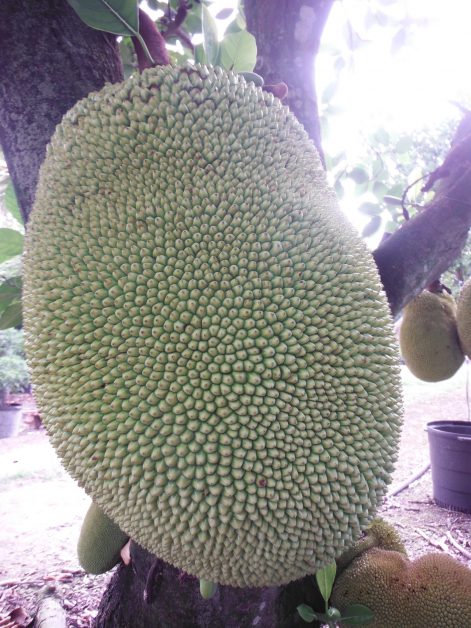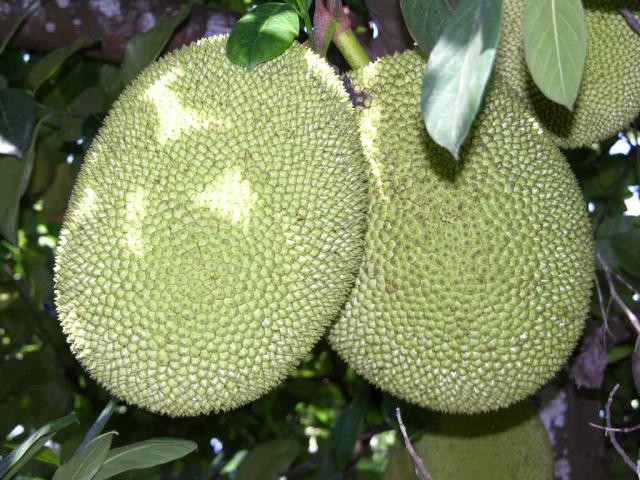World’s Largest Fruit on a Tree — and Yummy, Too!
We’ve all heard about 1,600-lb. pumpkins and 270-lb. watermelons. Those are impressive weights, and fortunately the fruits had the ground to support them as they increased in size. But do you know the largest fruit that grows on a tree? It’s the jackfruit (or jakfruit), and not only is it big, but it’s also very tasty – and versatile. Let’s take a brief look at what makes this odd-looking food so popular around the tropics.
The jackfruit tree (Artocarpus heterophyllus) is native to India, but, like most plants that possess economic value, it is now cultivated in other parts of the world. A jackfruit tree in native habitat may reach 80 ft. tall, but in southern Florida, a mature height of 40 ft. is more the norm, and trees in a residential lot can be maintained, through selective pruning, at 10-12 ft. without seriously affecting fruiting. And while the tree itself can grow quite stately, it is the fruit that distinguishes it – round or oblong, rough-skinned, and, above all, HUGE. The mechanism that allows a tree to support hefty fruit is cauliflory, meaning that the fruit develops on the trunk and major branches, which are capable of bearing great weight. Some cultivars of A. heterophyllus grow fruit that ripens at 100 lbs., but others mature in the 10-25 lb. range. The fruits are known botanically as syncarps; like pineapples, raspberries, blackberries and mulberries, they consist of multiple individual flowers and their resulting fruitlets fused into a compound fruit.
In subtropical southern Florida, jackfruit has proven to be quite dependable, usually flowering on an annual basis. In most years, the crop is available from May to October. The best way to tell if an individual fruit is ready to eat is to pick it up as soon as it falls off the tree. Of course, that practice has its risks if you happen to be standing in the wrong place. Concussions are not cool. The second-best way to detect a ripe jackfruit is the sniff test to see if you can discern a sweet aroma featuring notes of bananas and pineapples. But it’s not just ripe jackfruits that attract fans; many Southeast Asian recipes use green fruit.
Further testimony to the jackfruit’s versatility is the fact that it can be eaten fresh, cooked, frozen or dehydrated. The most delicious part of a jackfruit is its arils, the fleshy material that surrounds the seeds; they are usually of a more vibrant color than the adjacent, more fibrous material known as rag. If you are a newcomer to dissecting the fruits, you might find these suggestions helpful in dealing with the latex inside: (1) Wear throwaway plastic gloves, such as the nitrile gloves used in medical offices; (2) Lubricate the blade of your cutting knife with vegetable oil; and (3) Slice the jackfruit open lengthwise on a newspaper. If you’re planning to cook a 2-3 lb. green jackfruit, first drop it into boiling water to make it easier to peel.
How can you choose a good jackfruit to grow at home? It’s fairly easy. Because jackfruit grows true to seed, i.e., its seedlings almost always have the characteristics of the original plant, you can just plant seeds of a fruit which you found tasty. Exactly what does jackfruit taste like? Some people have said that it reminds them of Juicy Fruit gum, and a few even claim that the gum is made using jackfruit. That’s probably not provable, because the exact ingredients in the gum are a trade secret, but some observers speculate that the aroma of both jackfruit and Juicy Fruit is like that produced by isoamyl acetate, a chemical compound associated with sweet, fruity smells.
While the jackfruit trees at Richard Lyons’ Nursery are still in production, you can drop by to purchase a whole fruit, priced by weight.
- Artocarpus heterophyllus (Jackfruit 86 lbs.)
- Artocarpus heterophyllus (Jackfruit) on the tree.
We close with a few recipes recommended by Noris Ledesma, Curator of Tropical Fruit at Fairchild Tropical Botanic Garden:
Jackfruit Casserole (serves 4)
- 2 eggs
- 1 cup mayonnaise
- 1 can cream of mushroom soup
- 1 cup grated cheddar cheese
- 1 tsp minced onion
- 2 cups green jackfruit flesh (cooked)
Preheat oven to 450°F. In a medium bowl, beat eggs. Blend in mayonnaise and cream of mushroom soup. Stir in cheese, minced onion and jackfruit. Turn into a 2 quart casserole. Bake for 45 minutes.
Jackfruit Salad (Serves 4)
- 6 cups fresh jackfruit
- Juice of one lime
- 1 cup sweetened shredded coconut
- ¾ cup golden raisins
- 16 ounces sour cream
- ¾ to 1 cup toasted walnuts – optional
In a large mixing bowl, combine jackfruit, lime juice, coconut, raisins and sour cream. If, after combining all ingredients, you feel mixture needs more of one above item, slowly add according to your taste. Add and mix in toasted walnuts just before serving.
NOTE: Place walnuts on a cookie sheet, single layer, and toast 8 to 10 minutes in a preheated 300-degree oven. Turn walnuts over after 4 or 5 minutes.
Jackfruit Patties (serves 8)
- 4 cups green Jackfruit flesh (uncooked) 4 cups heavy cream
- 2 eggs
- 3 cups flour
- ¼ cup scallions, chopped
- ¼ cup onions, chopped
- 1 tsp sugar
- 1 tsp salt
Mix jackfruit and whipping cream. Beat eggs. Gradually beat in flour. Mix in sugar, salt scallions and onions. Stir in jackfruit mixture. Mix well. Shape into patties. Fry in hot oil, browning on each side.
Jackfruit Compote on the Light Side
- 4 cups jackfruit arils diced in quarters or eights
- ½ cup water
- 1 cup sugar
- 1 full tsp finely diced ginger
- 1 tsp lemon juice
- 1 tsp lemon zest
- 1 tsp cloves
- 1 cinnamon stick
Place the sugar and water in pot over medium heat to melt the sugar. Add all the other ingredients in the order shown. Cook until the jackfruit is soft, about ten minutes.

